Grow the Best Peppers
Weldon Burge
CONTENTS
Introduction
For American gardeners, peppers are second only to tomatoes in popularity. They produce well in limited space, are virtually free of pests and diseases, and are fairly easy to grow. The plants are attractive in the garden; many people grow several varieties just for their decorative touch.
Bell peppers are the most popular and familiar, but in recent years there has been heightened interest in the vast selection of peppers many of which are only available if you grow them yourself. If your only experience with peppers has been green bell peppers for stuffing, roasting, or slicing, youve barely scratched the surface. Peppers, particularly the hot varieties, have gained popularity as more and more ethnic foods come into vogue, including Spanish, Italian, Mexican, Indian, Hunan, Szechuan, Thai, Indonesian, Vietnamese, and Arab dishes. The fruits provide a diversity of shapes, sizes, colors, and flavors that add variety to your garden and pizzazz to your cooking.
A Brief History of Peppers
Peppers are indigenous to tropical America, where they were extensively cultivated centuries before Columbus set foot in the New World. Dried peppers have been found in Peruvian ruins that pre-date the birth of Jesus Christ!
In 1492, when Christopher Columbus and his crew discovered the New World, they also discovered the green and red Capsicums that were common in the West Indies. They assumed from the fruits pungency that they had found a new variety of the table pepper they were so fond of in Europe.
A variety of hot and sweet peppers were found throughout the West Indies, Mexico, Central America, and South America. These quickly caught on with Europeans, who enjoyed them mainly as a seasoning. The fruits soon became synonymous with the ground pepper spice imported from Asia hence the name pepper.
Europeans began cultivating their own pepper plants, and carried them to all parts of the globe. Hot peppers were common fare in Africa, the Middle East, India, and much of Asia by the 17th century. In fact, the pepper is one of the New Worlds major contributions to the cuisine of the Old World.
Although peppers are native to the Americas, it wasnt until after they had grown popular throughout Europe that they were introduced to North America. European settlers brought them back to the New World, and soon peppers were cropping up all over the colonies.
Pepper Classifications
Peppers are members of the Nightshade Family, which includes the tomato, potato, and eggplant. Although they are herbaceous perennials, they are generally grown as annuals.
In parts of Europe, peppers are called capsicums, their botanical name. Some historians believe the name came from the Latin capsa, or box, because of their shape. Others believe the name came from the Greek word capto I bite.
If you thumb through several seed catalogs, you will find that peppers often defy classification or at least provide some confusion. For example, Cayenne, Jalapeo, and Bell are all type names, each representing a group of peppers that may contain many cultivars. Yet, a seed catalog may offer a variety called Cayenne or Jalapeo. This list shows common groupings with some representative varieties.
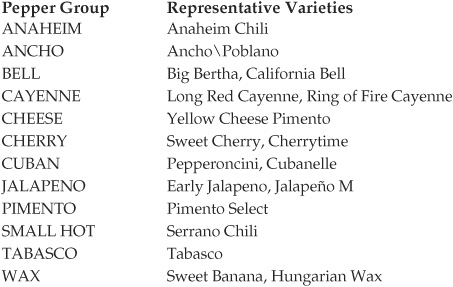
To add to the confusion, the same variety of pepper may have different names in different contexts. For example, an Ancho pepper is the dried version of the fresh Poblano pepper however, it can be found under both or either name in seed catalogs. This is particularly confusing in ethnic cookbooks. A Mexican cookbook may call for Habaneros; a Jamaican recipe may call for Scotch Bonnets both are the same pepper.
If you need help with the different groups and names, look for the guide Capsicum Pepper Varieties and Classification (Circular #530) posted online at the website of New Mexico State University.
For the sake of simplicity, in this bulletin well divide the vast number of varieties into two groups: sweet peppers and hot peppers.
Sweet Peppers
There are probably plenty of green bell peppers in your local supermarket; perhaps some overpriced yellow and red bells, and maybe some Italian frying peppers. Very little else.
If youre looking for green peppers for stuffing, roasting, or slicing for salads or crudits, many bell varieties will suffice. They range in size from the enormous (Big Bertha, King of the North) to the miniature (Jingle Bells, Little Dipper). The green peppers are actually immature fruits. Allowed to ripen, most turn red or yellow with a sweeter, milder flavor and a finer texture. In fact, those expensive gourmet red and yellow bells are merely green peppers that have matured.
You arent limited to the green bells. You can grow purple bell peppers (Purple Beauty, Lilac Belle, Islander), brown (Chocolate Bell, Sweet Chocolate), yellow (Golden Summer, Honey Belle, Orobelle), orange (Ariane, Corona, Valencia), and even creamy white bells (Ivory Charm). Many green bells mature to red early (Ace, Early Thickset, North Star).
Sweet peppers range far beyond the bell peppers. You can select from the long frying types (Cubanelle, Biscayne, Italia), the small cherry varieties (Cherrytime, Sweet Cherry), and the pickling types (Sweet Pickle, Sweet Banana, Pepperoncini).
The following is only a sampling of the many sweet peppers available from seed catalogs.
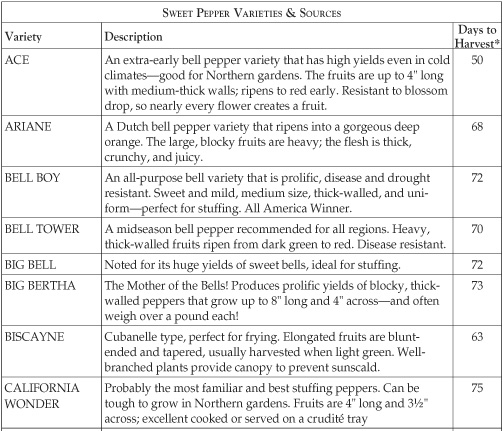
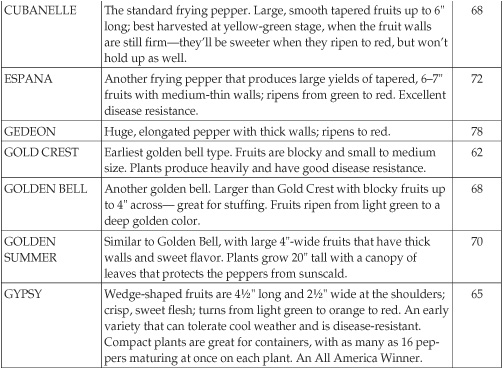
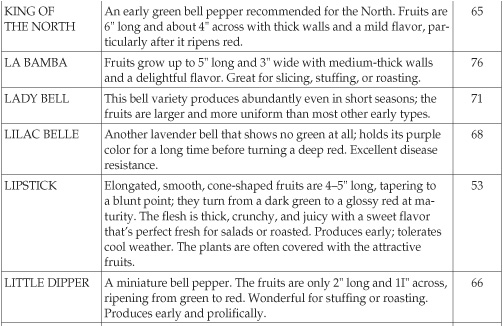
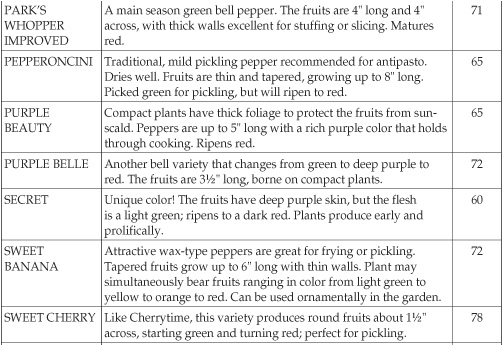
Hot Peppers
Like sweet peppers, hot peppers have many shapes, colors, and flavors. They range in heat from the slightly pungent Anaheims to the blistering Habaeros.
Many people believe the smaller the pepper, the hotter it is. Or that red peppers are hotter than green ones. Not true! Serranos are picked green and are longer than the chunky Jalapeos, but they are far hotter than Jalapeos. Variety determines how hot a pepper will be, not color, shape, or size.
Growing conditions such as soil quality, moisture, and temperature also influence the hotness of a pepper. A Cayenne will always be hotter than an Anaheim. But a Cayenne grown in New Mexico, where the soil is poor and the climate is arid, will be hotter than the same variety grown in New York, where it is cool and damp. Thats why some of the hottest chilis come from Mexico and the Southwest.
What Makes Hot Peppers Sizzle?
Researchers at New Mexico State University have identified at least six compounds in hot peppers that pour on the heat, but the chief chemical ingredient is capsicin, a crystalline alkaloid that acts as an irritant.
The degree of heat in hot peppers can be measured on a scale using Scoville units. Created by William Scoville in 1912, the scale refers to the parts per million of capsicin in a pepper variety. Scoville discovered that the human tongue can detect as little as 1 part per million of the substance. A mild Anaheim may reach 1,400 on the scale, but a Tabasco could reach 50,000 and a fiery Habaero up to 350,000!







